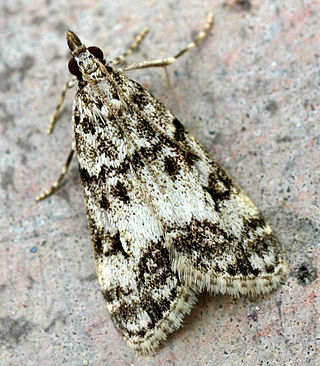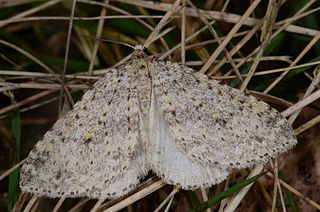
Cerapteryx graminis, the antler moth, is a moth of the family Noctuidae. It is a common species throughout most of Europe but is lacking in the very dry southern regions. The northernmost occurrence is Iceland, and above the Arctic Circle. It also occurs in Siberia and in North Mongolia. The species has been introduced to North America. In the Alps it rises to an altitude of 2100 meters.

Daphnis nerii, the oleander hawk-moth or army green moth, is a moth of the family Sphingidae. It was described by Carl Linnaeus in his 1758 10th edition of Systema Naturae.

Hippotion celerio, the vine hawk-moth or silver-striped hawk-moth, is a moth of the family Sphingidae. It was described by Carl Linnaeus in his 1758 10th edition of Systema Naturae.

Eudonia lacustrata is a species of moth of the family Crambidae described by Georg Wolfgang Franz Panzer in 1804. It is found in Europe, north-west Africa, Asia from Turkey, Iran and Syria to Siberia and the western part of China (Hunan). The subspecies E. lacustrata persica is found in Iran and Armenia.

Eudonia mercurella is a species of moth of the family Crambidae. It is found in Europe, western China, Iran, Lebanon, Turkey, and north-western Africa.

Anaplectoides prasina is a species of moth of the family Noctuidae. It is found in both the Palearctic and Nearctic realms.

Eudonia philerga is a species of moth of the family Crambidae. This species was first described by Edward Meyrick. It is endemic to New Zealand, found throughout the country, and regarded as common. Larvae feed on moss. Adult moths have been observed on the wing more frequently from October to April, and are attracted to light.

Eudonia is a large and widespread genus in the grass moth family (Crambidae), subfamily Scopariinae. There is no common name for the roughly 250 species placed here; new species are still being described regularly. Although the genus was proposed early in the 19th century, many of these moths were for a long time retained in Scoparia, the type genus of the subfamily and a close relative of Eudonia. A few small genera have been proposed for separation from Eudonia, but given the size of this group this is not particularly convincing; thus, all are retained here pending a comprehensive phylogenetic review.

Scoparia pyralella, the meadow grey, is a species of moth of the family Crambidae. It was first described by Michael Denis and Ignaz Schiffermüller in 1775.

Eudonia murana, the Scotch gray or wall grey, is a moth of the family Crambidae. It was described by John Curtis in 1827 and is found in most of Europe.

Eudonia angustea is a moth of the family Crambidae described by John Curtis in 1827. It is found in southern and western Europe, the Canary Islands, Madeira and Turkey.

Eudonia laetella is a species of moth in the family Crambidae described by Philipp Christoph Zeller in 1846. It is found in Fennoscandia, the Baltic region, Belarus, Russia, Poland, the Czech Republic, Slovakia, Hungary, Romania, Bosnia and Herzegovina, the Republic of Macedonia, Greece, Slovenia, Austria, Switzerland, Italy, Germany and Belgium.

Eudonia lineola is a species of moth in the family Crambidae. It is found in Great Britain, Ireland, the Netherlands, France, Spain, Portugal and on Sardinia, the Canary Islands, as well as in North Africa, including Morocco.

Eudonia sudetica is a species of moth in the family Crambidae described by Philipp Christoph Zeller in 1839.

Colostygia multistrigaria, the mottled grey, is a species of moth in the family Geometridae. It is found in western and south-western Europe and North Africa. The habitat is damp woodlands, heaths, and mosses.

Parastichtis suspecta, the suspected, is a species of moth in the family Noctuidae. It is found from most of Europe through Russia and east through the Palearctic to Japan. It is also found in North America.

The Beautiful Gothic(Leucochlaena oditis) is a Palearctic moth of the family Noctuidae, sub-family Cuculliinae. It is found in southern Europe and north Africa, with occasional finds on the southern coast of England.

Eudonia aspidota is a moth in the family Crambidae. It is found in New Zealand and can be found in the North, South and Stewart Islands. The species inhabits native forest and its larvae lives on mosses.

Eudonia hemiplaca is a moth in the family Crambidae. It was described by Edward Meyrick in 1899. It is endemic to New Zealand.

Eudonia oculata is a moth in the family Crambidae. It was described by Alfred Philpott in 1927. This species is endemic to New Zealand and is said to be found only in the South Island, however specimens have also been observed in the lower parts of the North Island and at Chatham Island. This species inhabits grass or shrub land as well as lowland to alpine tussock habitat. Adults are commonly on the wing from November until April and are attracted to light.



















